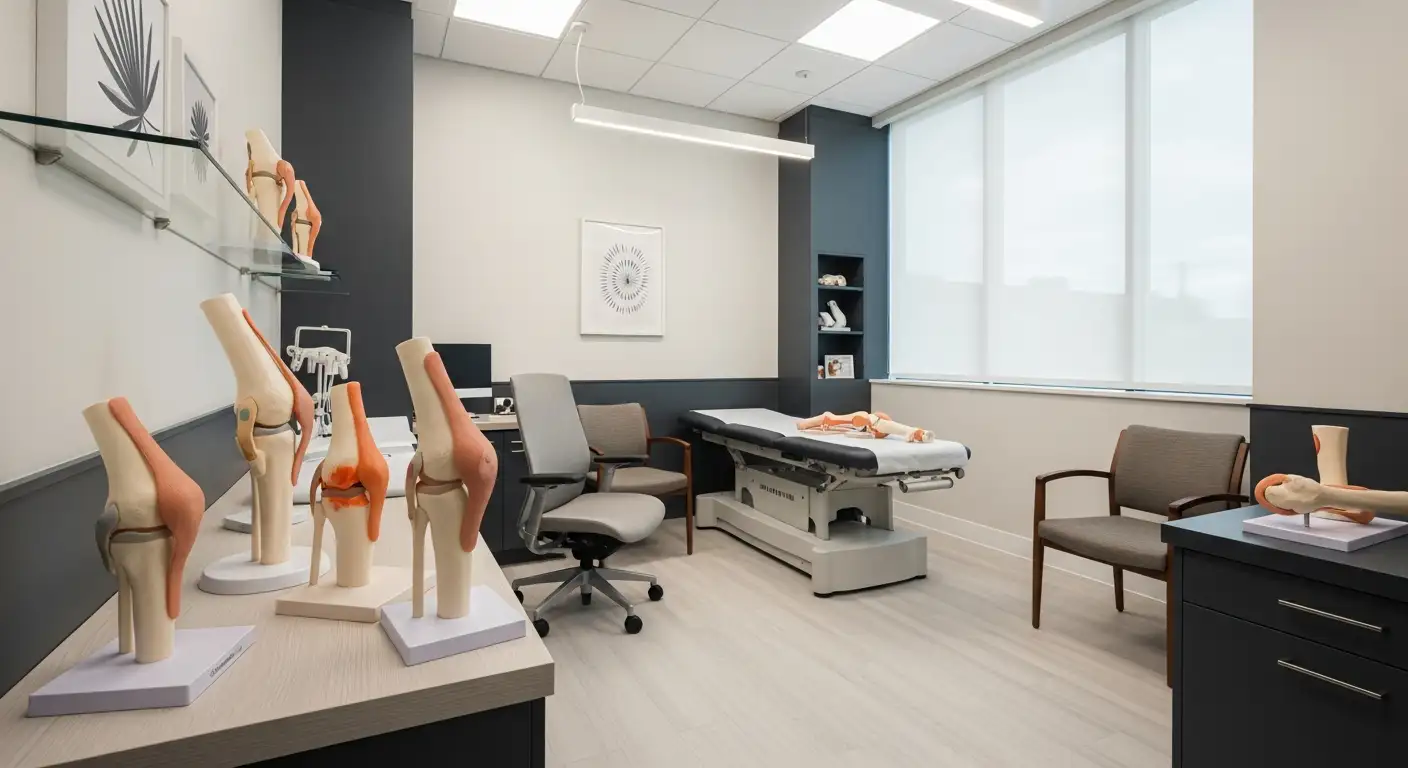Deciphering the Complexities of Knee Muscle Contractions
Knee spasms are involuntary contractions of the muscles surrounding the knee joint, often causing discomfort or pain. While occasional spasms are common and usually harmless, frequent or severe episodes may indicate underlying medical issues. This comprehensive overview explores the causes, symptoms, diagnostic approaches, and management strategies for knee spasms, aiming to educate readers on this prevalent but often misunderstood condition.
Symptoms Associated with Knee Spasms
What are the symptoms associated with knee spasms?
Knee spasms are involuntary muscle contractions affecting the muscles surrounding the knee. These spasms can be uncomfortable and sometimes painful, presenting several recognizable symptoms.
One of the primary signs is sudden muscle tightness or a feeling of cramping in the knee area. This quick tightening can be quite startling and may cause the knee to feel hard or tense.
Visible twitching of the muscles around the knee often accompanies spasms, making the involuntary contractions noticeable. Along with twitching, some individuals might experience sharp or burning pain during or after the spasms.
The tight, cramp-like sensation can lead to temporary reduced mobility, making it difficult to bend, straighten, or bear weight on the affected knee. On occasion, spasms can last from a few seconds to several minutes, depending on their cause.
The severity of symptoms can vary widely. Mild spasms may only cause fleeting discomfort, while more intense or prolonged spasms can significantly impair movement and activity.
If knee spasms become frequent, severe, or are accompanied by other symptoms such as swelling or weakness, consulting a healthcare provider is recommended for proper diagnosis and treatment.
Causes of Knee Spasms and Muscle Twitching
Knee spasms and muscle twitching are common experiences that can stem from a variety of causes. Understanding these triggers can help in managing and preventing discomfort.
One of the primary reasons for spasms and twitching is muscle fatigue and overuse. When muscles around the knee are overworked, especially without proper rest or stretching, they can become prone to involuntary contractions and twitches.
Dehydration and electrolyte imbalances also play a significant role. Minerals like calcium, potassium, and magnesium are essential for normal muscle function. When these minerals are depleted due to insufficient hydration or excessive sweating, muscle fibers may misfire, leading to spasms.
Nutrient deficiencies, particularly in vitamins D, B-6, and B-12, can contribute to nerve and muscle issues. These deficiencies affect the nerves and muscles around the knee, sometimes causing twitching or cramps.
Underlying health conditions further influence these symptoms. Arthritis, which causes joint inflammation, may lead to discomfort and muscle spasms in the knee. Nerve damage, such as from injuries to the peroneal nerve, can cause localized twitching and weakness. Additionally, autoimmune disorders like neuromyotonia (Isaac syndrome) involve uncontrollable muscle spasms and twitching.
Lifestyle factors also significantly impact muscle health. Excessive consumption of caffeine or alcohol can overstimulate muscles, provoking twitching. Poor stretching routines, inadequate conditioning, or sudden increases in activity can strain muscles, triggering spasms.
Most cases of mild twitching are benign and temporary. However, persistent or severe spasms merit medical attention. A healthcare professional can evaluate for underlying conditions, perform necessary tests, and suggest appropriate interventions.
| Cause Category | Specific Factors | Explanation |
|---|---|---|
| Muscle-related | Fatigue, overuse, poor conditioning | Excessive activity without adequate rest or stretching |
| Nutritional | Dehydration, calcium, magnesium, potassium deficiencies | Imbalances disrupt nerve and muscle function |
| Vitamin and Mineral Deficiencies | Vitamin D, B-6, B-12 depletion | Affect nerve signaling and muscle response |
| Medical Conditions | Arthritis, nerve damage, autoimmune disorders (neuromyotonia) | Underlying health issues can cause or worsen spasms |
| Lifestyle Factors | Excess caffeine or alcohol, inadequate stretching | Overstimulation and muscle strain |
Preventive measures include staying well-hydrated, maintaining a balanced diet rich in essential nutrients, regularly stretching before physical activity, and avoiding excessive caffeine or alcohol intake. If spasms are frequent, painful, or accompanied by other symptoms like weakness or swelling, seeking medical advice is important to diagnose any underlying health conditions.
Prevention of Knee Muscle Spasms and Cramps
 Knee muscle spasms and cramps are common issues that can cause discomfort and restrict movement. Fortunately, there are several effective strategies to prevent them.
Knee muscle spasms and cramps are common issues that can cause discomfort and restrict movement. Fortunately, there are several effective strategies to prevent them.
Regular stretching exercises play a vital role in keeping the muscles around the knee flexible and healthy. Targeted stretches for the calves, hamstrings, and quadriceps help improve muscle elasticity, reducing the likelihood of sudden spasms. Incorporating these stretches into your daily routine can make a significant difference.
Proper hydration and managing electrolyte levels are also essential. Dehydration and imbalances in minerals such as potassium, magnesium, and calcium can increase the risk of cramps. Drinking plenty of water throughout the day and including foods rich in these nutrients can help maintain optimal muscle function.
Wearing supportive footwear and maintaining good posture can reduce strain on your knees. Avoiding high heels and using shoes that provide proper arch support decrease undue pressure that can lead to muscle strain and spasms. Good posture ensures even distribution of weight and lessens muscle fatigue over time.
Strengthening the muscles around the knee and maintaining a healthy weight further protect against spasms. Strength exercises for leg muscles can improve stability and reduce joint stress. Losing excess weight decreases pressure on the knees, lessening the chance of overuse and injury.
In addition to these measures, applying heat or cold to tense muscles can help in preventing spasms. Gentle massage of the area also promotes circulation and relaxes tight muscles, reducing the likelihood of cramps.
By adopting these habits—regular stretching, hydration, proper footwear, strength training, and targeted heat or massage—you can reduce the risk of knee spasms and cramps, maintaining healthier and more comfortable knees.
Post-Surgical and Ligament-Related Knee Spasms
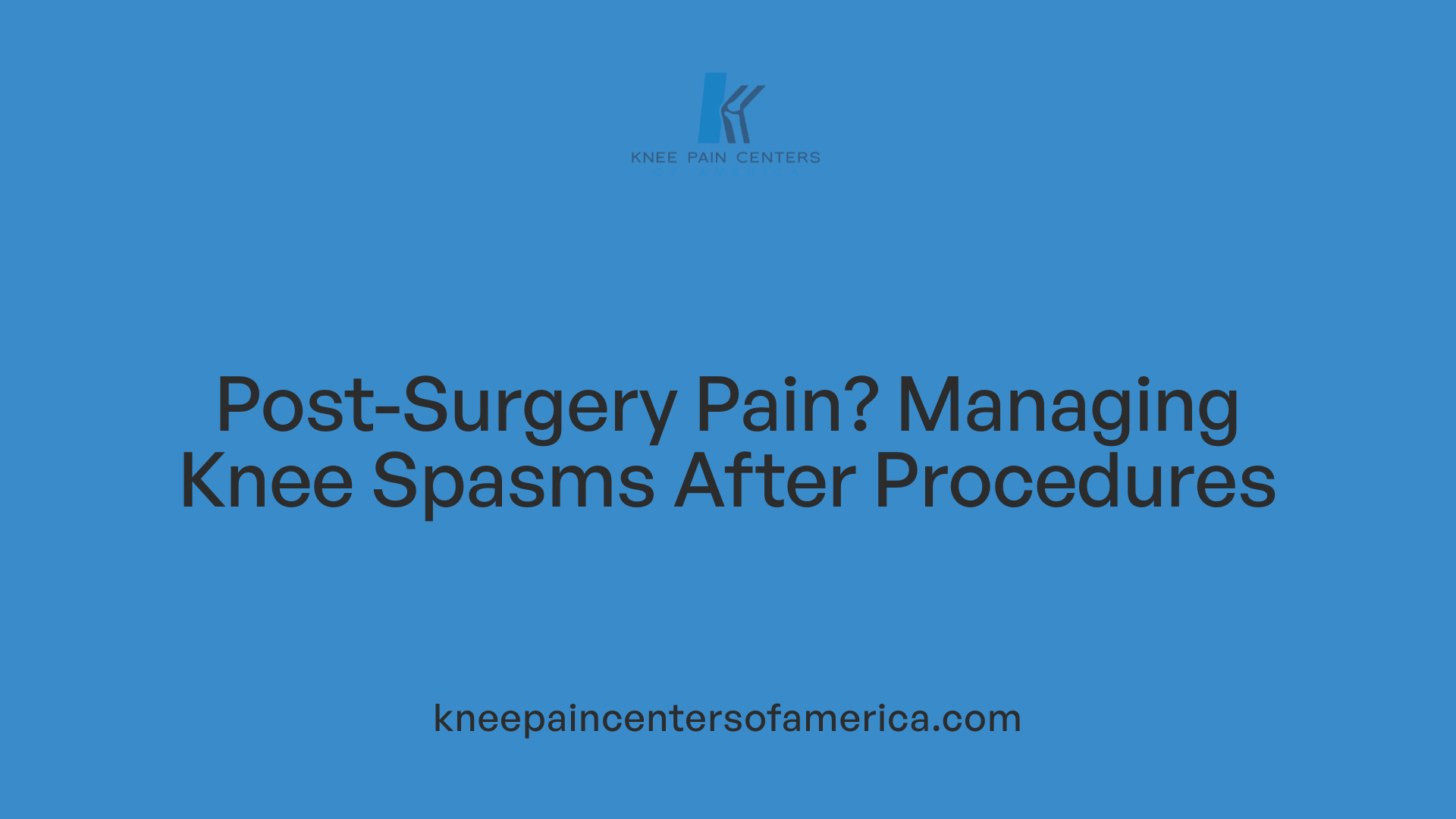 Knee spasms are common after surgery or injury, often linked to nerve irritation, ligament damage, or joint instability. These involuntary muscle contractions can occur as part of the body’s response to healing, overuse, or inflammation.
Knee spasms are common after surgery or injury, often linked to nerve irritation, ligament damage, or joint instability. These involuntary muscle contractions can occur as part of the body’s response to healing, overuse, or inflammation.
Nerve irritation following knee surgery is a frequent cause of spasms. During procedures such as ligament repairs or reconstructive surgeries, nerves near the surgical site may become inflamed or damaged. This nerve disturbance can lead to abnormal firing signals, resulting in spasms, burning sensations, or discomfort around the knee.
Ligament injuries, like anterior cruciate ligament (ACL) tears or laxity in other ligaments, often cause instability. When ligaments are damaged, the knee may become loose or unstable, leading muscles around the joint to overcompensate. This overactivity can trigger spasms as the muscles attempt to stabilize the knee, especially during movement or weight-bearing.
Joint inflammation and instability also contribute to spasms. Inflamed tissues, scar tissue formation, and swelling after injury or surgery can irritate surrounding nerves and muscles. In addition, improper healing or weak rehabilitation may prolong instability, making muscles tense and prone to spasms. When the joint is unstable or inflamed, muscles may contract involuntarily to protect or support the knee.
Nerve damage, whether from direct injury during surgery or nerve compression due to swelling, nerve impingement, or scar tissue, can directly cause muscle spasms. Damaged nerves may misfire, leading to persistent or episodic spasms, sensory disturbances, or burning sensations in the knee.
Effective rehabilitation and physical therapy are crucial in managing knee spasms post-surgery or injury. Targeted exercises help strengthen surrounding muscles, improve joint stability, and promote proper nerve function. Pain management, including anti-inflammatory treatments and, in some cases, nerve blocks or stimulation therapy, may be necessary.
In summary, knee spasms after surgery or due to ligament issues are interconnected phenomena involving nerve irritation, structural instability, inflammation, and muscle overcompensation. Proper medical guidance, a structured rehabilitation program, and, when needed, addressing nerve health can significantly reduce spasms and support full recovery.
Diagnosis of Knee Spasms and Related Conditions
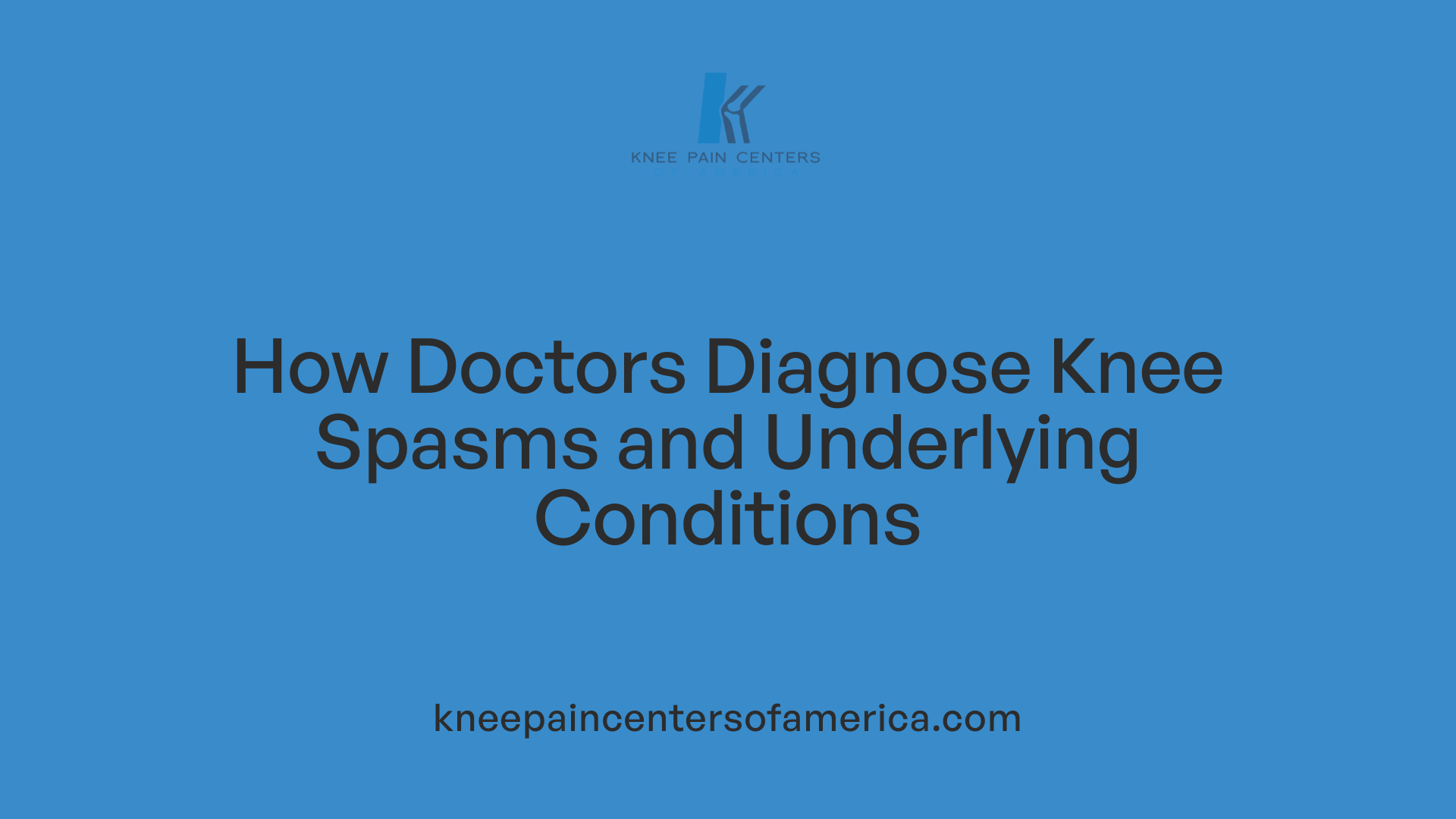 Muscle spasms in the knee can be uncomfortable and disruptive, but understanding how they are diagnosed is essential for effective treatment. The diagnostic process begins with a thorough medical history and physical examination. A healthcare provider will ask about the frequency, duration, triggers, and any other symptoms related to the spasms. During the physical exam, the doctor looks for signs such as swelling, tenderness, or limited movement and may perform specific tests to observe how the muscles respond.
Muscle spasms in the knee can be uncomfortable and disruptive, but understanding how they are diagnosed is essential for effective treatment. The diagnostic process begins with a thorough medical history and physical examination. A healthcare provider will ask about the frequency, duration, triggers, and any other symptoms related to the spasms. During the physical exam, the doctor looks for signs such as swelling, tenderness, or limited movement and may perform specific tests to observe how the muscles respond.
To identify underlying causes, several diagnostic tests may be used. Blood tests are common to evaluate electrolyte levels, including calcium, magnesium, and potassium, since deficiencies can contribute to spasms. Imaging techniques like X-rays or MRI scans help visualize structural issues such as joint damage, arthritis, or ligament injuries that might be causing or aggravating muscle contractions.
In cases where nerve involvement is suspected, nerve conduction studies are performed. These tests assess how well electrical signals travel through the nerves, helping identify nerve compression, pinched nerves, or nerve damage. If joint inflammation or fluid buildup is suspected, analysis of joint fluid can be conducted to detect infection or other issues.
Combining these evaluation methods allows medical professionals to accurately diagnose the root causes of knee spasms and plan appropriate treatments. This comprehensive approach ensures that both symptomatic relief and underlying problems are addressed.
Differentiating Knee Spasms from Other Knee Pain Conditions
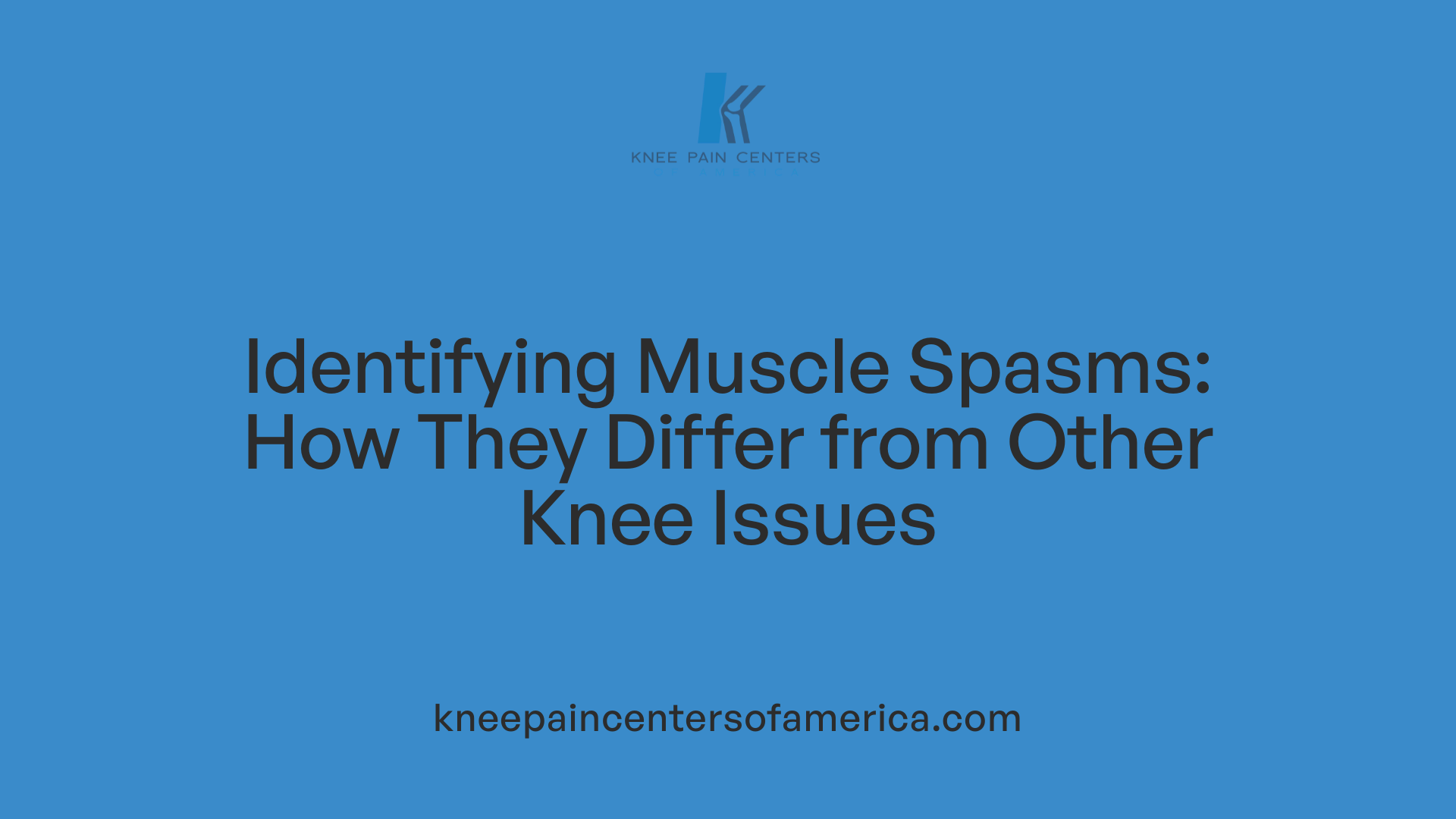 Knee spasms are characterized by sudden, involuntary contractions of the muscles surrounding or near the knee. These spasms can cause a sharp, sometimes painful tightening of the muscle, often accompanied by twitching or a pulling sensation. One of the main features that set spasms apart from other knee pain conditions is their rapid onset and the fact that they may occur suddenly during activity or rest.
Knee spasms are characterized by sudden, involuntary contractions of the muscles surrounding or near the knee. These spasms can cause a sharp, sometimes painful tightening of the muscle, often accompanied by twitching or a pulling sensation. One of the main features that set spasms apart from other knee pain conditions is their rapid onset and the fact that they may occur suddenly during activity or rest.
Unlike structural injuries such as ligament tears, meniscal damage, or joint inflammation, knee spasms rarely involve significant swelling, redness, or mechanical symptoms like locking or clicking of the knee joint. Instead, they primarily affect the muscle belly or tendon, leading to localized tightness or twitching, especially in muscles like the quadriceps or hamstrings.
Knee spasms often improve quickly with gentle stretching, massage, or rest. Patients may notice relief after stretching the affected muscle or changing positions, in contrast to injuries that tend to worsen with movement or require medical intervention.
During a spasm, examination can reveal heightened muscle tone, twitching, or firmness in the affected muscle group, without joint instability or deformity. The absence of swelling, joint locking, or abnormal movement helps differentiate muscle spasms from structural or inflammatory knee problems.
Understanding recent activity, such as vigorous exercise or prolonged walking, fatigue, or nerve irritation, can further aid in distinguishing spasms from other causes of knee discomfort. Overall, the sudden onset, muscular nature, quick relief with stretching, and lack of joint swelling are key indicators that the pain is due to a spasm rather than more serious structural damage or inflammation.
Related Medical Conditions and Underlying Causes
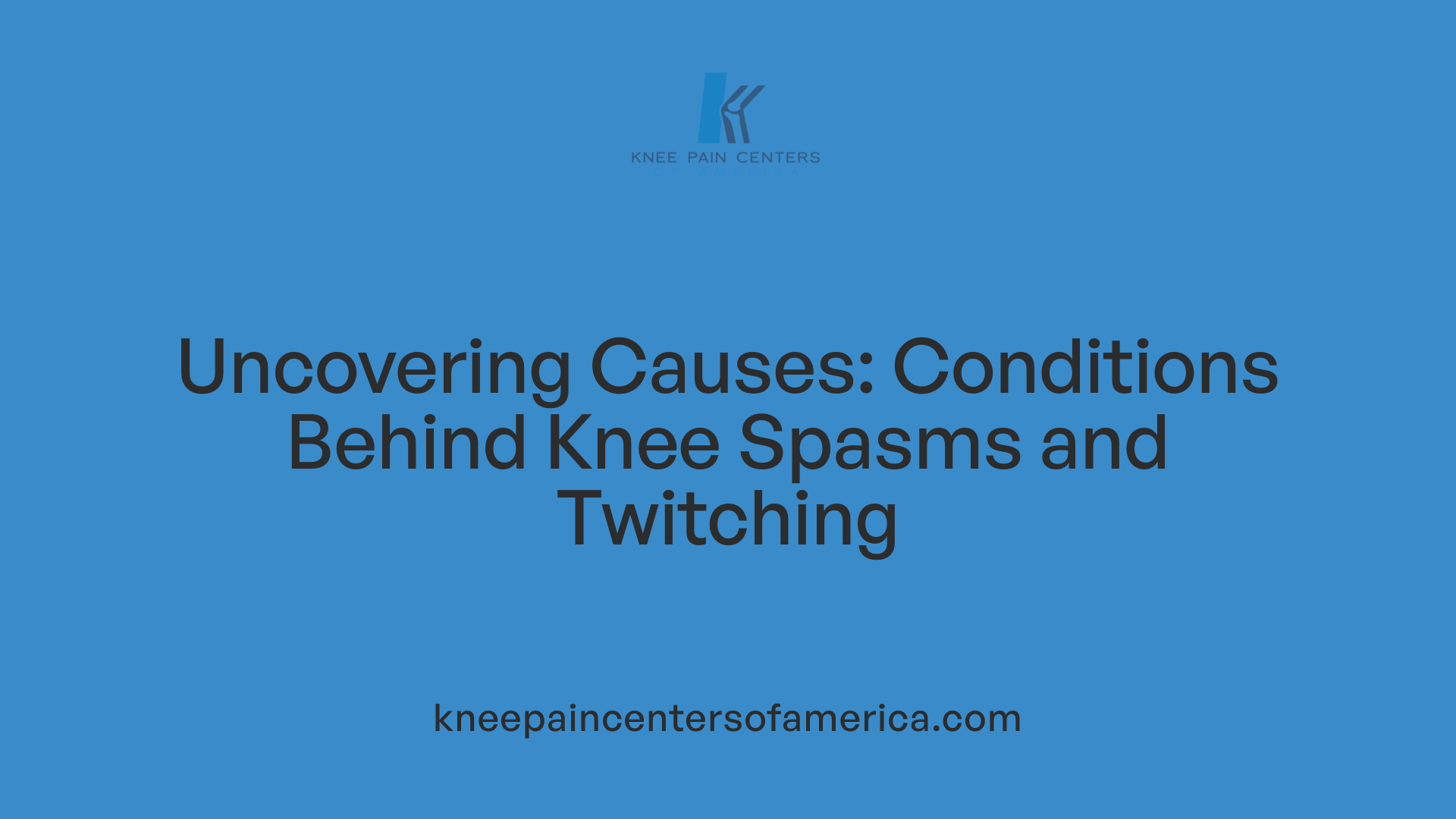 When experiencing knee twitching or spasms, it's important to consider potential underlying medical causes. Several conditions can contribute to these involuntary movements.
When experiencing knee twitching or spasms, it's important to consider potential underlying medical causes. Several conditions can contribute to these involuntary movements.
One common medical issue is nerve compression or pinched nerves. This can occur when nerves leading to the knee are compressed by surrounding tissues, causing twitching, tingling, or numbness in the area.
Structural injuries to the knee, such as ligament tears (like ACL injuries), meniscus damage, or patellofemoral pain syndrome (also known as runner's knee), may also result in muscle spasms. These injuries often lead to inflammation and instability, prompting the muscles around the knee to contract involuntarily as a protective response.
Knee arthritis, especially osteoarthritis, is another culprit. The deterioration of joint cartilage causes inflammation, which can lead to muscle spasms as the body's way of stabilizing the joint.
Neurological disorders are linked as well. Conditions like spinal stenosis, nerve injuries (such as peroneal nerve damage), and disorders like multiple sclerosis or dystonia can cause abnormal nerve signals that trigger muscle twitching in the knee region.
Systemic health issues also play a role. Dehydration, electrolyte imbalances (particularly with minerals like potassium, magnesium, and calcium), diabetes, and thyroid problems can disturb nerve function and muscle control, resulting in spasms or twitching.
In summary, knee muscle spasms are often associated with a spectrum of medical conditions. Understanding these underlying causes can help guide effective treatment and management.
| Medical Condition | Effect on Knee Muscles | Additional Details |
|---|---|---|
| Nerve compression/nerves | Causes twitching, tingling, or weakness | Often due to herniated discs or bone spurs |
| Ligament/muscle injuries | Lead to spasms during healing process | Examples: ACL tear, ligament sprain |
| Arthritis | Inflammation and pain, muscle spasms | Common in osteoarthritis cases |
| Neurological disorders | Abnormal nerve signals causing twitching | Includes MS, dystonia, nerve injuries |
| Systemic issues | Mineral imbalances cause muscle instability | Includes dehydration, diabetes, thyroid |
Understanding these conditions is vital in diagnosing and treating persistent knee twitching or spasms, especially when they are severe, frequent, or accompanied by other symptoms.
Treatment Strategies and Management Options
What are the treatment options and management strategies for knee spasms?
Managing knee spasms involves a combination of approaches aimed at relieving symptoms and addressing root causes. Initial steps often include simple home remedies such as rest, applying ice to reduce inflammation, compression with bandages or support braces, and elevation of the leg to decrease swelling.
Over-the-counter medications like nonsteroidal anti-inflammatory drugs (NSAIDs) can help reduce pain and muscle inflammation. Muscle relaxants may also be prescribed by a healthcare provider if muscle tightness significantly impairs movement or comfort.
Physical therapy plays a crucial role in recovery and prevention. Targeted exercises to strengthen the muscles around the knee, along with stretching routines, can improve stability and flexibility. Physical therapy also teaches proper movement techniques to reduce strain and prevent future spasms.
In cases where conservative measures are ineffective, more advanced procedures might be considered. These include corticosteroid injections for significant inflammation or nerve blocks to interrupt pain signals. Surgery, such as repair or reconstruction of damaged ligaments or removal of the damaged tissue, is reserved for severe cases involving structural damage or persistent instability.
Overall, treatment plans should be tailored to the individual’s specific condition, underlying causes, and overall health to ensure effective and lasting relief.
Managing Knee Spasms Effectively
Knee spasms are a common condition with a variety of potential causes, from benign muscle fatigue to underlying neurological or structural problems. Proper diagnosis, which includes patient history, physical examination, and diagnostic testing, is essential for effective management. Treatments focusing on addressing underlying causes, along with lifestyle modifications such as hydration, stretching, and strengthening, can significantly reduce the frequency and severity of spasms. In cases where spasms are severe, persistent, or associated with other concerning symptoms, consulting a healthcare professional is crucial for targeted therapy, including physical therapy, medications, or surgical options. With appropriate care and preventive strategies, individuals can maintain healthy, functional knees and improve their quality of life.
References
- Knee Twitching: Causes and Treatment - Healthline
- Knee Muscle Spasm | Florida Orthopaedic Institute
- Why Is My Knee Twitching? | Arthritis Knee Pain Centers
- Knee Twitching & Spasms - Centeno-Schultz Clinic
- Knee Muscle Spasm: Relief and Prevention Essentials - Docus.ai
- Muscle Spasms (Muscle Cramps): Causes, Treatment & Prevention
- Muscle spasms: Causes, symptoms, and treatment
- Patellofemoral pain syndrome - Symptoms and causes - Mayo Clinic



